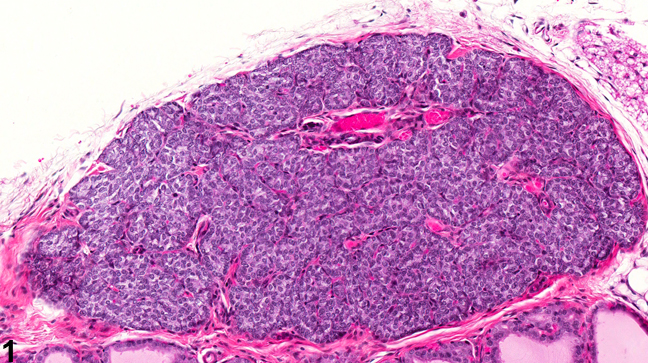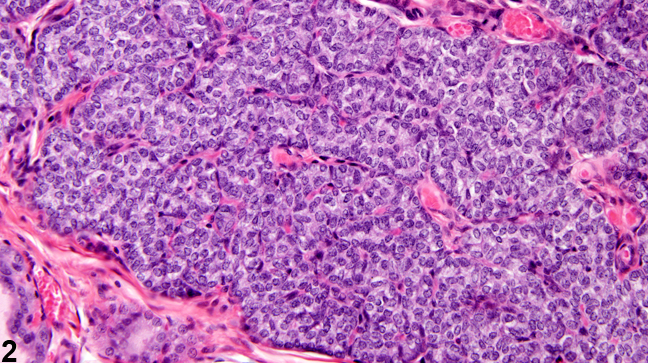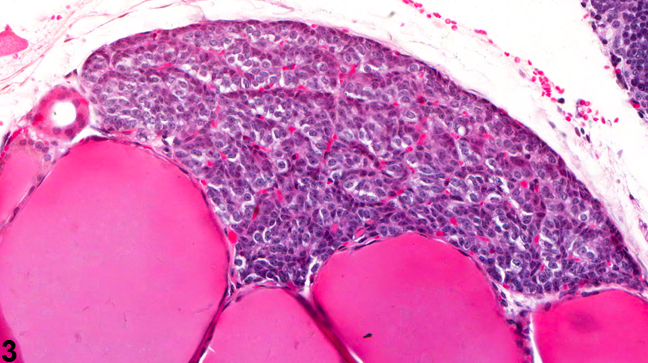Endocrine System
Parathyroid Gland
Narrative
The paired parathyroid glands are typically located on the anterolateral edge of the thyroid glands. In the rat they are 1-2 mm in length and considerably larger in females than in males. Accessory parathyroid tissue is sometimes located adjacent to the thymus. Parathyroids are lightly encapsulated and consist of highly folded branching cords and nests of polygonal cells separated by a delicate fibroreticular stroma. The principal cell type in the rat is the chief cell with a spherical to oval nucleus. Tinctorial properties of the cytoplasm vary, and the presence of clear or dark cells reflects different functional status of the chief cells. Chief cells in the mouse parathyroid may be clear or dark, with an increase in clear cells in older mice. Cytoplasmic volume or nuclear density of the chief cells (on a glandular level) is a relative indicator of parathyroid hormone synthesis and secretion. Glands with larger chief cells due to greater cytoplasmic volume are typically more active. Changes in cell density and morphology may be subtle, so side-by-side comparison of study control parathyroid glands with those of treated rodents is recommended to best assess these changes.

Figure 1. Parathyroid Gland - Normal in a male F344/N rat from a chronic study. The normal parathyroid is lightly encapsulated and located on the edge of the thyroid.

Figure 2. Parathyroid gland - Normal in a male F344/N rat from a chronic study. This higher magnification of Figure 1 shows the nests and chords of polygonal cells separated by a delicate fibroreticular stroma in a male F344/N rat from a chronic study.

Figure 3. Parathyroid gland - Normal in a male B6C3F1 mouse from a chronic study. Normal parathyroid located at the edge of the thyroid.

Figure 4. Parathyroid gland - Normal in a male B6C3F1 mouse from a chronic study. This higher magnification of Figure 3 shows the nests and cords of polygonal cells separated by a delicate fibroreticular stroma.
Capen CC, Rosol TJ. 1989. Recent advances in the structure and function of the parathyroid gland in animals and the effects of xenobiotics. Toxicol Pathol 17:333-345.
Abstract: http://www.ncbi.nlm.nih.gov/pubmed/2675284Capen CC, DeLellis RA, Yarrington JT. 2002. Endocrine system. In: Handbook of Toxicologic Pathology, Vol 2 (Haschek WM, Rousseaux CG, Wallig MA, eds). Academic Press, New York, 681-783.
Abstract: http://www.sciencedirect.com/science/book/9780123302151Hardisty JF, Boorman GA. 1999. Thyroid and parathyroid glands. In: Pathology of the Mouse: Reference and Atlas (Maronpot RR, Boorman GA, Gaul BW, eds). Cache River Press, Vienna, IL, 537-554.
Abstract: http://www.cacheriverpress.com/books/pathmouse.htmSeely JC, Hildebrandt PK.. 1990. Parathyroid gland. In: Pathology of the Fischer Rat: Reference and Atlas (Boorman GA, Eustis SL, Elwell MR, Montgomery CA, MacKenzie WF, eds). Academic Press, San Diego, 537-543.
Abstract: http://www.ncbi.nlm.nih.gov/nlmcatalog/9002563
